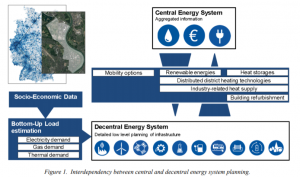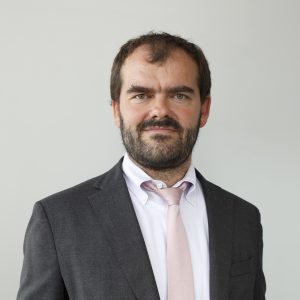Integrated planning of multi-energy systems: a comprehensive modelling framework
Bischi, A.*, Thie, N., Schwaeppe, H., Schumann, K., Ferrari, L., Gordini, A., Paronuzzi, P., Punzo, A., Cakirer, K.B., Acan, B., Crisostomi, E., Desideri, U., Pozzi, M.*
The paper “Integrated planning of multi-energy systems: a comprehensive modelling framework” (Bischi, A., Thie, N., Schwaeppe, H., Schumann, K., Ferrari, L., Gordini, A., Paronuzzi, P., Punzo, A., Cakirer, K.B., Acan, B., Crisostomi, E., Desideri, U., Pozzi, M.) will be presented at the 9th Conference on the Regulation of Infrastructures (25-26 June, 2020).
ABSTRACT
The European Union’s commitment towards a carbon-neutral economy can only be achieved by a synergistic implementation of measures, ranging from improved energy efficiency to increased share of Renewable Energy Sources (RES). The achievement of such ambitious objectives depends on a continuous technological innovation, from units performance improvement to digitalization, as well as
the possibility to store and convert energy in all its forms, from electric (e.g. electric vehicles), to thermal/cooling (e.g. Power to Heat solutions), to chemical (e.g. Power to Gas and Liquid fuels) and other commodities. Therefore, innovation, digitalization, storage and conversion will enable new market models as well as energy infrastructures integration (electric, gas, thermal/cooling and mobility)
to be capable to leverage upon the flexibility provided by a fully integrated energy system. Energy infrastructures have traditionally been designed separately from each other and often focusing on national or even local needs, without considering the wider picture from EU level down to single countries, and when possible, to local communities. In contrast, an integrated planning approach allows for determining the cost-efficient target system, including the trade-off between investing in different technologies or types of infrastructure (e.g. increasing flexibility vs. grid expansion). This target system will help policy makers in deciding how to incentivize technologies and to steer the system in direction of cost-efficiency and climate-neutrality. Therefore, an integrated planning of multi-energy systems as a decision support tool for policy makers becomes increasingly important to reach the abovementioned EU targets.
Methodologically, the envisioned tool will model the investment decision of energy supply structures in electricity, gas, heating/cooling and mobility sectors on transmission and distribution level, aiming at an efficient transition from the current energy system to an environmentally sustainable one. The objective function minimizes the overall energy system costs including capital expenditures (CAPEX)
for investment decisions and operational expenditures (OPEX) for system operation. Among the constraints, we could identify: energy sectors-coupling constraints, grid constraints, energy conversion units’ performance constraints, time-coupling constraints, the latter could become challenging for long-term periods, e.g. seasonal storage, affecting the size of the problem to solve. Large-scale generation and storage units will be modelled on a single unit level, while distributed generation and storage units will be integrated in a simplified manner via regional or nodal aggregation as regional sub problems.
A fully formulated problem would result in a challenging non-linear optimization problem. Therefore, state of the art operations research, as well as best engineering practices, will be applied to break it down into treatable sub-problems, formulated as Convex or Linear Programming (LP) when possible, to determine the marginal value of different commodities, or Mixed Integer Linear Programming
(MILP) when zero/one variables have to be taken into account in the decisional problem.
Overall, the problem is divided into two stages: a central one, Europe-wide planning, and a decentralized one, with increasing levels of detail concerning the regional resolution. The two problems will be iteratively solved, Figure 1. The European-wide planning is based on a scenario framework for the target year (e.g. 2050) including relevant technological or cost parameters. Additional model inputs originate from the status quo system, including existing grid infrastructure, energy conversion units and demand. Uncertain parameters like consumption, prices and political framework trends will be varied within sensitivity analyses. Depending on data availability, the Europe-wide planning can be subdivided into a focus region and the rest of Europe. Within the focus region, the demand data on electricity, heat and mobility is generated by a bottom-up modelling approach based on available socio-economic and weather data implying the need of high granularity data, e.g. postal code areas. The rest of Europe outside the focus region is modelled topdown relying upon available overall commodities consumption and energy conversion units to determine the Europe-wide supply task. In a second stage, the regional results of the first stage planning tool are further broken down and planned in higher granularity on selected decentral test cases. Such detailed granularity will be useful to find out shortcomings at distribution grid level, which may influence the transmission level (e.g., the solution from the first stage is technically not feasible, or a feasible solution can just be achieved with very high costs). Feedback shall be given to the first stage planning tool and input parameters have to be iteratively adjusted or additional limitations have to be added smoothening conflicts in the objectives.
 Concluding, the proposed methodology, expected to lead at Europe-wide central planning, helps to analyse how the focus region can contribute to either its own or supra-national climate goals. At distributed level, the regional energy transition plan will be assessed based on the aggregated expansion targets determined by the central planning. Therefore, the main question of the decentralized case study will be the integration of the new assets into the distribution grid area considering grid expansion measures as well as operational strategies. The evaluation of results and the comparison of sensitivity analyses will be based on the calculations of Key Performance
Concluding, the proposed methodology, expected to lead at Europe-wide central planning, helps to analyse how the focus region can contribute to either its own or supra-national climate goals. At distributed level, the regional energy transition plan will be assessed based on the aggregated expansion targets determined by the central planning. Therefore, the main question of the decentralized case study will be the integration of the new assets into the distribution grid area considering grid expansion measures as well as operational strategies. The evaluation of results and the comparison of sensitivity analyses will be based on the calculations of Key Performance
Indicators (KPIs) costs and emissions related.
ABOUT THE AUTHORS
 Following a M.Sc in Mechanical Engineering (2007) from University of Perugia (Italy), Aldo Bischi received his Ph.D. in “Energy and Process Engineering” (2012) from the Norwegian University of Science and Technology-NTNU (Norway) working on chemical reactor systems design, construction and commissioning applied to Carbon Capture and Storage (CCS). From 2012 until 2015, Aldo held an adjunct professorship and post-doctoral position in the “Group of Energy COnversion Systems” – GECOS at Politecnico di Milano (Italy), being awarded of prestigious “Polimi International Fellowships”. He worked on distributed power generation: Combined Cooling, Heat and Power (CCHP) systems, dealing with all CCHP aspects from technical to economic point of view. Since 2016 he works as Assistant Professor at Skolkovo Institute of Science and Technology (Russian Federation), part-time since 2018. In Skoltech he extended his research to the flexibilization of energy systems in several directions, ranging from the integration of energy infrastructures electric, thermal and gas networks, to electric and thermal energy storage integration, as well as load control and uncertainty impact; the latter in a joint project with Massachusetts Institute of Technology (MIT), USA, where he spent a trimester in 2017 as Visiting Scientist in the department of Mechanical Engineering. From 2018 he joined the University of Pisa, Italy, as Postdoctoral Research associate widening his activities to the P2P energy markets and blockchain applied to energy systems. In the meantime, he co-founded an innovative start-up, TIFEO srl which is member of a consortium that got recently awarded a prestigious H2020 RIA Grant: “Next renewable multi-generation technology enabled by two-phase fluids machines”. Aldo’s scientific production lists above 30 peer-reviewed publications and above 400 citations with H-index of 10. He co-chaired international conferences such as the COST Action final conference: TD1207. “Optimization for efficient and robust energy networks” and got awarded by the Italian Ministry of Education the Associate Professor habilitation for thermal machines and energy systems.
Following a M.Sc in Mechanical Engineering (2007) from University of Perugia (Italy), Aldo Bischi received his Ph.D. in “Energy and Process Engineering” (2012) from the Norwegian University of Science and Technology-NTNU (Norway) working on chemical reactor systems design, construction and commissioning applied to Carbon Capture and Storage (CCS). From 2012 until 2015, Aldo held an adjunct professorship and post-doctoral position in the “Group of Energy COnversion Systems” – GECOS at Politecnico di Milano (Italy), being awarded of prestigious “Polimi International Fellowships”. He worked on distributed power generation: Combined Cooling, Heat and Power (CCHP) systems, dealing with all CCHP aspects from technical to economic point of view. Since 2016 he works as Assistant Professor at Skolkovo Institute of Science and Technology (Russian Federation), part-time since 2018. In Skoltech he extended his research to the flexibilization of energy systems in several directions, ranging from the integration of energy infrastructures electric, thermal and gas networks, to electric and thermal energy storage integration, as well as load control and uncertainty impact; the latter in a joint project with Massachusetts Institute of Technology (MIT), USA, where he spent a trimester in 2017 as Visiting Scientist in the department of Mechanical Engineering. From 2018 he joined the University of Pisa, Italy, as Postdoctoral Research associate widening his activities to the P2P energy markets and blockchain applied to energy systems. In the meantime, he co-founded an innovative start-up, TIFEO srl which is member of a consortium that got recently awarded a prestigious H2020 RIA Grant: “Next renewable multi-generation technology enabled by two-phase fluids machines”. Aldo’s scientific production lists above 30 peer-reviewed publications and above 400 citations with H-index of 10. He co-chaired international conferences such as the COST Action final conference: TD1207. “Optimization for efficient and robust energy networks” and got awarded by the Italian Ministry of Education the Associate Professor habilitation for thermal machines and energy systems.

Matteo Pozzi is Partner and Chief Executive Officer of Optit since 2010. Following his MSc in Physics and a Diploma in International Relations from the School of Advanced International Studies of the Johns Hopkins University – Bologna Centre, he spent more than 15 years in management consulting in the UK and Italy, working with increasing responsibilities in large business transformation projects with strong focus on the interdependencies between operations and ICT, with particular focus on the Energy & Utilities markets. This experience is now consolidating and expanding in Optit, where optimization modelling and advanced analytics are being applied in the development of innovative decision support systems, with particular focus to the District Energy business, contributing to the advancement of digital transformation in the DHC and CHCP industry. Current work is increasingly focusing on sector coupling optimisation, ranging from increasing plants’ operating margins with respect to trading strategies up to strategic long term planning of large scale scenarios, like in the PlaMES project that will be presented at the conference.
Acknowledgements
“This project has received funding from the European Union’s Horizon 2020 research and innovation
programme under grant agreement No 863922″.
*presenting author






